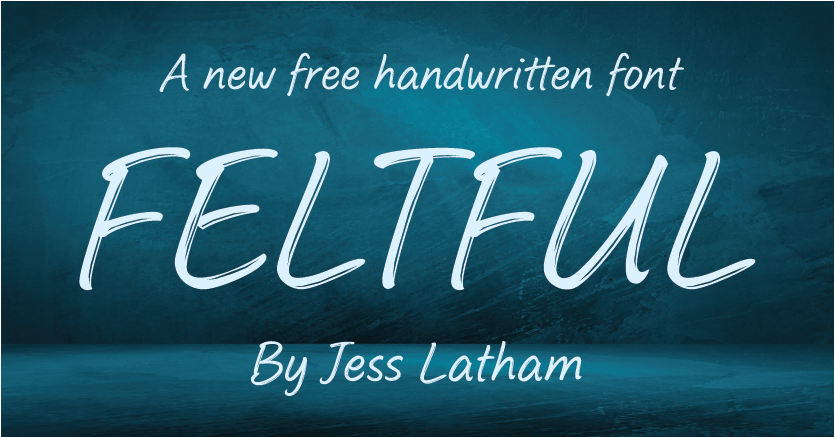Feltful, a charming handwritten font by Jess Latham, offers a touch of cozy intimacy to your designs. Imagine a warm letter penned by a loved one, its letters imbued with a friendly informality. That’s the essence Feltful captures.
While not possessing the elaborate flourishes of some script fonts, Feltful’s gentle curves and rounded edges exude a sense of warmth and approachability. It’s a versatile choice for designs that aim to connect with viewers on a personal level.

License
100% Free
Handwritten Fonts
In the symphony of typography, handwritten fonts stand as the haunting melodies, the echoes of quill on parchment. Unlike their sterile, machine-minted counterparts, they carry the whisper of a human hand, the lilt of a crafted line, and the weight of personality etched in every curve. In a world awash in digital sheen, handwritten fonts offer a welcome dose of endearing imperfection, a bridge back to a time when communication was a tangible experience.
The history of handwritten fonts is as intricately interwoven with the evolution of writing itself as it is with the rise of the printing press. Early scribes meticulously sculpted letterforms by hand, breathing life into them with a unique spirit. The printing press ushered in an era of standardized typefaces, but the yearning for the personal touch lingered. The 19th century witnessed a resurgence of hand-drawn lettering, particularly in the realm of flamboyant posters and elaborately adorned packaging. These early examples, boasting dramatic flourishes and intricate embellishments, aimed to capture attention and evoke a sense of artisanal craft.
The 20th century dawned with a new chapter for handwritten fonts. The arrival of phototypesetting empowered designers to capture and replicate hand-drawn lettering with newfound ease. This sparked an explosion of creativity, with fonts reflecting a kaleidoscope of styles, from the whimsical flourishes of the Art Deco era to the clean lines of mid-century modernism. The rise of graphic design further solidified the role of handwritten fonts in visual communication. From iconic logos like Coca-Cola’s Spencerian script to the playful lettering adorning children’s book illustrations, handwritten fonts became a potent tool for designers to forge brand identities and evoke specific emotions.
The digital revolution has democratized handwritten fonts like never before. Online platforms like DaFont and Google Fonts have become vast treasure troves, overflowing with thousands of options catering to every imaginable visual style. This accessibility has empowered a new generation of designers and enthusiasts to weave the warmth and personality of handwritten fonts into their projects. From crafting personalized greetings brimming with sentiment to designing logos with a hand-drawn aesthetic, the creative possibilities are boundless.
However, with such a vast selection comes the challenge of discerning the ideal font for the task at hand. Unlike standard fonts engineered for optimal readability, handwritten fonts often prioritize aesthetics over ease of reading. Script fonts, for example, with their flowing lines and intertwined letters, might be visually captivating but can be challenging to decipher in large blocks of text. Discerning the nuances of different handwritten styles, from casual scribbles to formal calligraphy, becomes paramount.
Beyond aesthetics, the power of handwritten fonts lies in their ability to conjure specific emotions and establish a distinct atmosphere. A playful, bouncy font might be ideal for a children’s website, while a bold, energetic script could add a touch of dynamism to a sports brand logo. A delicate, flowing script font, on the other hand, could lend an air of elegance and sophistication to a wedding invitation or a luxury brand advertisement.
The inherent informality of handwritten fonts also makes them ideal for projects seeking a personal touch. Imagine a handwritten note left for a loved one, its letters imbued with a warmth that a typed message simply cannot replicate. Handwritten fonts can capture that same sentiment in digital creations, adding a layer of authenticity and connection.
But the influence of handwritten fonts extends beyond the realm of visual communication. They play a pivotal role in user experience design (UXD). In an age of digital overload, handwritten fonts can act as visual cues, drawing attention to important information or creating a sense of interactivity. Imagine a call to action written in a friendly, handwritten font; it feels more like a personal invitation than a sterile button.
In conclusion, handwritten fonts are more than just digital recreations of penmanship. They are a bridge between the human and the digital, a way to inject warmth and personality into a world dominated by clean lines and perfect pixels. They offer designers a powerful tool for communication, allowing them to evoke emotions, create brand identities, and connect with viewers on a human level. So, the next time you delve into a font library, take a moment to appreciate the artistry and emotion embedded within those digital inscriptions – the handwritten fonts that whisper tales of human touch in a digital world.













